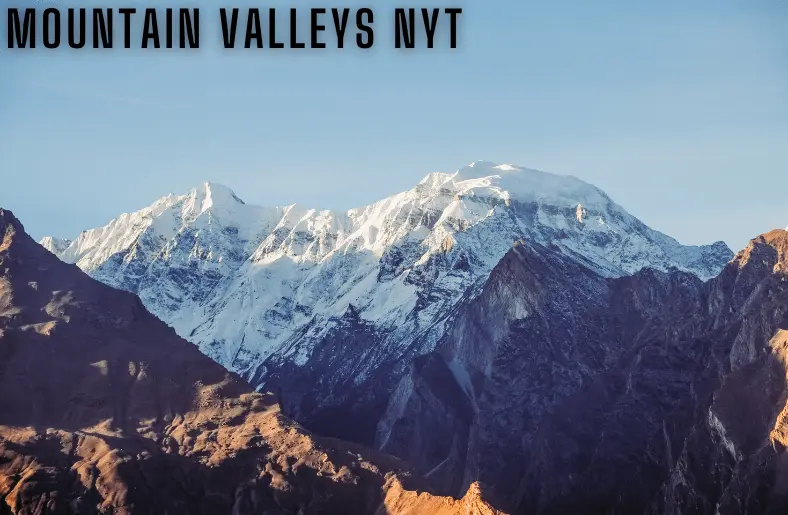Mountain Valleys NYT captivates with its breathtaking landscapes and tranquil beauty. Often sculpted by glaciers or rivers, these valleys reveal nature’s artistry. From their dramatic vistas to their lush vegetation, they embody nature’s hidden masterpieces. In this exploration, we uncover what makes these valleys so enchanting. Transitioning from their geological formation, we delve into their diverse ecosystems. Each valley, with its unique charm, offers a glimpse into nature’s grandeur. Understanding these natural wonders provides insight into their allure and significance. Join us as we journey through the captivating world of mountain valleys.
The Enchantment of Mountain Valleys NYT
Mountain valleys are nature’s hidden gems, offering unparalleled beauty and tranquility. First, their dramatic landscapes captivate the eye. Next, lush greenery and diverse flora add to their charm. Additionally, crystal-clear rivers and serene lakes enhance their allure. As sunlight filters through towering peaks, it creates stunning vistas. Transitioning from rocky cliffs to gentle meadows, these valleys showcase nature’s artistry. Furthermore, the blend of natural elements creates a peaceful haven for wildlife. Ultimately, the magic of mountain valleys lies in their ability to inspire awe and wonder. Exploring these enchanting spaces reveals their true splendor.
Geological Wonders
Mountain valleys are shaped by powerful geological forces. Initially, glaciers carve out broad, U-shaped valleys. As these ancient ice masses recede, they leave behind stunning formations. Simultaneously, rivers create V-shaped valleys through persistent erosion. Over time, these forces sculpt dramatic landscapes. Consequently, the interplay of ice and water crafts diverse terrain. Transitioning from rugged cliffs to smooth, rounded hills, the geological history unfolds. Additionally, sediment deposits add layers of complexity to the landscape. These geological wonders offer insight into Earth’s dynamic processes. Ultimately, they reveal the intricate beauty shaped by nature’s forces.
Biodiversity and Ecosystems
Mountain Valleys NYT teem with diverse life forms. Firstly, their unique climates support varied ecosystems. Alpine meadows, for instance, are rich in wildflowers. Consequently, these meadows attract a multitude of insects and birds. Additionally, the varied terrain fosters habitats for mammals and amphibians. Each valley has its microclimate, influencing the species present. Furthermore, the interaction between flora and fauna creates balanced ecosystems. Transitioning from lush vegetation to rocky outcrops, different species thrive. As a result, mountain valleys become biodiversity hotspots. Ultimately, these ecosystems highlight the delicate balance of nature’s intricate web.
Cultural and Historical Significance
Mountain valleys hold profound cultural and historical value. Initially, ancient civilizations thrived in these fertile lands. As a result, many early settlements emerged in these valleys. These regions often feature archaeological remains of past cultures. Additionally, they are central to various local myths and legends. For instance, indigenous groups view these places as sacred. Consequently, mountain valleys are integral to their spiritual traditions. Moreover, the valleys’ history is intertwined with folklore and rituals. Thus, they are not merely natural landscapes but cultural landmarks. Ultimately, these valleys preserve the rich heritage of human history.
Recreation and Tourism
Mountain valleys offer a variety of recreational activities. First, hiking trails wind through these stunning landscapes. Consequently, visitors can enjoy breathtaking views and fresh air. Additionally, camping in these areas provides a serene escape from urban life. For adventure enthusiasts, rock climbing and mountain biking are popular options. Similarly, birdwatching and wildlife photography attract nature lovers. Moreover, these valleys often have well-marked paths for different skill levels. Therefore, they are accessible to both beginners and experienced adventurers. Finally, the natural beauty of these valleys enhances every outdoor experience.
Challenges and Conservation
Mountain valleys face significant challenges due to climate change. Rising temperatures impact glacial melting rates. Consequently, water sources become less reliable for ecosystems. Additionally, deforestation threatens the rich biodiversity of these regions. Invasive species further disrupt local habitats, leading to ecological imbalances. Moreover, increased tourism can strain natural resources and infrastructure. Therefore, conservation efforts are essential to address these issues. Protecting these areas involves reducing carbon emissions and promoting sustainable practices. Also, preserving local flora and fauna helps maintain ecological balance. Finally, educating the public about conservation is crucial for long-term success.
Mountain Valleys in The New York Times
The New York Times often highlights the beauty of mountain valleys. Articles showcase stunning visuals of these landscapes. Furthermore, they emphasize the unique recreational opportunities available. Readers frequently find information about hiking, camping, and scenic drives. Additionally, the coverage includes profiles of famous valleys and their features. Notably, the NYT explores the cultural and historical aspects of these regions. Each piece brings attention to the conservation efforts needed to protect these areas. Consequently, readers gain insight into both the allure and the preservation of mountain valleys.
Also Read Grunts NYT Crossword: Master the Clue
Conclusion
In summary, mountain valleys captivate with their natural splendor. They offer breathtaking views and unique ecosystems. Furthermore, their cultural and historical importance enriches our understanding of human-nature connections. As we explore these regions, preserving their beauty becomes crucial. Conservation efforts are essential to maintaining their ecological balance. Additionally, responsible tourism ensures these landscapes remain pristine for future generations. By appreciating mountain valleys, we also recognize the need for sustainable practices. Ultimately, these majestic valleys inspire awe and demand our commitment to their preservation.




